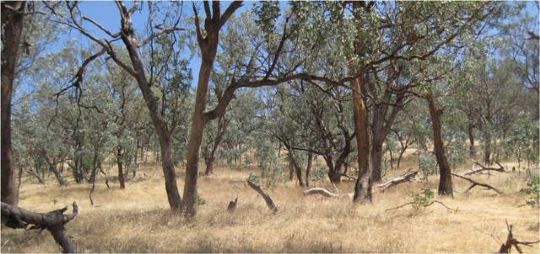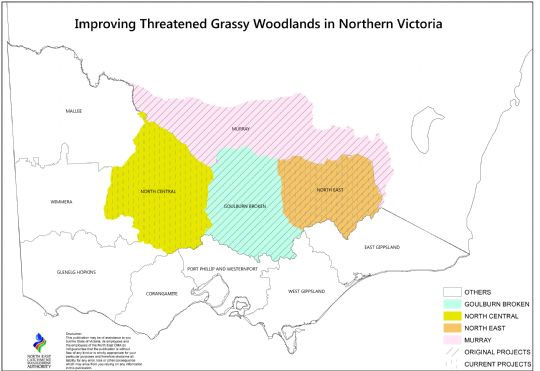
Image: Box Gum Grassy Woodlands. Photography: Matt Looby, the Department of Sustainability and Environment.
The Project
This project is now complete. See the reports at the end of this page for information on the project achievements. There are currently new projects addressing the Threatened Grassy Woodland Ecosystems.
The North East CMA was funded to deliver projects to Improve Landscape Scale Conservation of Threatened Grassy Woodland Ecosystems. Project partners included:
Department of Sustainability & Environment & Department of Primary Industries (now Department of Environment & Primary Industries) www.depi.vic.gov.au
Trust for Nature www.trustfornature.org.au
The Australian National University www.anu.edu.au
Goulburn Broken CMA www.gbcma.vic.gov.au
North Central CMA www.nccma.vic.gov.au
Murray CMA (now Murray Local Land Services) murray.lls.nsw.gov.au.
Nature Conservation Trust www.nct.org.au
Projects were funded by the Australian Government's Caring for our Country and the Department of Sustainability and Environment's Natural Resources Investment Program, together with support by the above mentioned partners.
The Objectives
Multi-regional Threatened Grassy Woodlands Project 2011-13
This project addressed 3 Caring for our Country Targets using rigorous and integrated landscape scale management of threatened grassy woodlands in Victoria's north-east and north-central NRM regions. It aimed to:
- Protect and enhance 580ha of threatened grassy woodlands (Box-Gum Grassy Woodland, Grey-Box Grassy Woodland and Buloke Woodland) by establishing contractual agreements with 44 land managers
- Engage 100 land managers in workshops and field days to improve knowledge and skills in effective woodland management and facilitate adoption of sustainable woodland practices
- Deliver 8 Indigenous community engagement projects within priority woodland areas to build capacity and youth involvement and record traditional ecological knowledge
North East Threatened Grassy Woodlands 2011-13
- 445ha of White Box-Yellow Box- Blakely’s Red Gum Grassy Woodland habitat improved
- 30 landholder agreements to manage remnant White Box-Yellow Box- Blakely’s Red Gum Grassy Woodland vegetation for biodiversity outcomes
- Involve the Indigenous community in building the understanding of Threatened Grassy Woodlands through use of Traditional Ecological Knowledge in extension material, field days.
Issues Addressed
This project recognised the critical need to reverse the decline of the Environment Protection and Biodiversity Conservation Act 1999 (EPBC Act) listed species and ecological communities: White Box – Yellow Box – Blakely’s Red Gum Woodland and Derived Native Grassland; Weeping Myall and Buloke Woodlands of the Riverina and Murray Darling Depression (“threatened grassy woodland”).
The project aimed to improve the understanding of, and engagement in, effective woodland management practises by land managers (public and private).
Why are Box-Gum Grassy Woodlands and Derived Grasslands Important?
This ecological community provides important habitat for a large number of plants and animals, including rare and threatened species such as Superb Parrots, Regent Honeyeaters and Squirrel Gliders.
The Box-Gum Grassy Woodlands and Derived Grasslands were formerly widespread along the western slopes and tablelands of the Great Dividing Range, throughout southern Queensland, western New South Wales, the Australian Capital Territory and Victoria.
Now less than 5 per cent remains in good condition and much of this occurs in small isolated patches. The remaining patches are still being lost due to clearing, weed invasion and overgrazing – hence the ecological community’s listing under the EPBC Act. (Source: White Box-Yellow Box-Blakely’s Red Gum grassy woodlands and derived native grasslands EPBC Act Policy Statement May 2006)
Asset Values
Community value
Several threatened grassy woodlands sites occur on Council managed land that is zoned PPRZ (Public Park and Recreation Zone). These areas are generally set aside for conservation and passive recreation use, e.g. walking, bike riding on walking trails and fire trails. These areas are particularly popular when close to major centers.
Many roads are lined by threatened grassy woodlands in varying states of health. Whilst most are impacted by weeds to varying degrees, roadsides are important landscape links and some of the most important threatened grassy woodlands remnant sites.
Environmental value
Threatened grassy woodlands provide many important functions within the landscape. They provide on-farm benefits, they contribute to the broader landscape by providing habitat for threatened species such as the Bush Stone Curlew and Squirrel Glider and add an aesthetically pleasing natural dimension in a highly modified landscape.
Remnants of this vegetation community are essential for the maintenance of the genetic diversity of our native flora and fauna species. These remnants also provide much of the seed that is used to re-vegetate farmland and other modified areas.
Threatened grassy woodlands are essential for the survival of vulnerable species such as the Superb Parrot, Regent Honeyeater and the Swift Parrot.
Economic value
Threatened grassy woodlands consist of deep rooted perennials which can help prevent and reduce dry land salinity by minimising the amount of water entering the water table.
With intact groundcover, they minimise soil loss and subsequent erosion problems by slowing the flow of water, allowing it to infiltrate the soil. In addition, threatened grassy woodlands provide:.
- Protection for stock, crops and pasture from heat, cold and wind.
- High intensity, short duration grazing opportunities.
- Habitat for native wildlife such as birds, bats, spiders, parasitic wasps and other insects which can act as natural pest control agents in pastures, crops and the woodland themselves.
What is the Geographic Project Area?
The 2011-13 funded project spanned priority threatened grassy woodland areas in Victoria's north-east and north-central Catchment regions.
In the north-east region these areas were focussed on the Northern Inland Slopes and Victorian Riverina bioregions, which extend from the central Upper Murray area south-west to the Warby Ranges.
In the north-central region the project encompassed priority threatened grassy woodlands of the Campaspe River catchment. These areas focus on the Goldfields and Victorian Riverina Bioregions, and encompass the mid-Campaspe and major tributaries from the Mount Camel Range extending west towards Mount Alexander Regional Park.
The original 2009-11 funded project work continued by contracted landholders across three Catchment regions: the North East (VIC), Goulburn Broken (VIC) and Murray (NSW) Catchments.
Map for grassy woodland

Further Information
ANU Biodiversity Baseline Surveys Final Report June 2011
CSU Social Research Report 24 Aug 2011
Indigenous Values of Box-Gum Grassy Woodlands
12th April 2010 - $3 Million to put threatened grassy woodlands on the radar
FAQ-ThreatenedGrassyWoodlands
20101220-SpecialRoadsideAreasToReceiveTLC
Woodlands Detectives at Work
Protecting Northern Victorian Gems
Connecting and Protecting - Grassy Woodlands Magazine